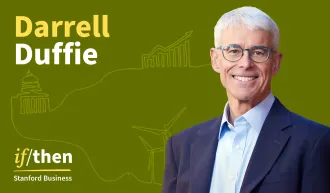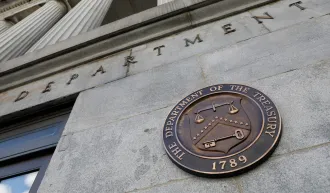Cost of Reducing CO2 Emissions Could Plunge
A study says the financial impact of regulating coal-fired power plants under a cap-and-trade system will be much less than previously projected.
October 01, 2009
There’s good news for supporters of the Waxman-Markey climate bill from Professor Stefan Reichelstein. Although passed by the U.S. House of Representatives in June 2009, the bill is expected to spur a contentious debate in the Senate starting this fall. Opponents argue that the bill’s proposed “cap-and-trade” system will take a high financial toll on energy consumers and companies alike, and devastate the economy at a time the country can least afford it.
Reichelstein and doctoral student Ozge Islegen believe they have evidence to the contrary. Reichelstein and Islegen have examined the financial impact of regulating coal-fired power plants that produce carbon dioxide emissions under a cap-and-trade system and found the financial burden to be much less than previously projected.
“We were very pleasantly surprised with the results, especially in light of previous cost estimates,” said Reichelstein, the Business School’s William R. Timken Professor of Accounting, who said that everyone agrees there will be a price associated with regulating carbon emissions. “But after several dire scenarios reported in the popular press, we became interested in measuring and quantifying exactly what that cost would be.”
They focused on three key questions. First, at what price for emission permits would fossil fuel power plants, in particular coal-based plants, invest in the new clean carbon capture and storage (CCS) technologies rather than buy such permits on the open market? “If the world wants sizable reductions — say cutting carbon dioxide emissions by 50% over the next 40 years — how high would the price of the emissions permits need to go before electric power producers and distributors would have a financial incentive to implement the new clean CCS technologies?” asked Reichelstein.
Second, will CCS technologies actually keep the market price of such emission permits reasonable? “In terms of carbon dioxide emissions, several sectors in the economy — for instance the whole transportation sector — could achieve sizeable reductions. How big a role CCS could play in keeping the market price of emission permits say under $60 per metric ton of carbon dioxide, was something we very much wanted to investigate,” said Reichelstein.
And finally, how far are electricity prices likely to rise in the case where two scenarios are both fulfilled: (1) if power generators are required to obtain emission permits; and (2) if CCS technology is available on the terms currently projected by engineering cost studies?
This last point is an important one. Although CCS technology has been documented in a number of pilot projects, it has yet to be proven for large commercial installations. FutureGen, an Illinois-based partnership of private firms and the U.S. government, is attempting to certify CCS technology for a commercial-sized coal-fueled power plant. If this is possible, then the cost savings possible by implementing CCS should scale well.
The implications for the environment are huge. In 2007, U.S. carbon dioxide emissions measured six gigatons. Roughly half of this came from fossil fuel plants, with coal-fired plants alone emitting two gigatons of carbon dioxide emissions. “The current projection for CCS technology is that it would clean up the carbon emissions of fossil fuel plants by 85%,” said Reichelstein. “That would take us a long way toward achieving the emission cut goals being mentioned in current public policy discussions.”
For coal-fired plants, Islegen and Reichelstein find that the break-even price for the adoption of CCS technology is just $25 to $30 per ton of carbon dioxide emissions. Once the price of emission permits moves beyond that range, operators of coal-fired power plants would find it advantageous to invest in CCS technology rather than buy emission permits. This finding stands in contrast to the conclusions of a widely quoted 2007 McKinsey & Co. study [“Reducing Greenhouse Gas Emissions: How Much at What Cost?”] that predicted the price of permits would have to reach $50 per ton before power plants would convert to CCS.
The sheer magnitude of emissions from coal-fired power plants in the United States and other parts of the world, most notably China, implies that the CCS option could be a major force in keeping the market price of emission permits relatively low. In connection with the Waxman-Markey climate bill, there has been debate about the need for a “safety valve.” Such a provision would require the U.S. government to issue more permits if the price of existing permits reached a certain threshold — say $75 per ton. “Our calculations suggest that the CCS option may ensure that such safety valves would not be activated,” said Reichelstein.
Although the price of electricity for consumers could rise as much as 23% — not an insubstantial amount — it’s significantly less than others have projected. “We were actually quite surprised that the impact on electricity prices was that small,” said Reichelstein.
Furthermore, because of the way the energy industry is regulated in the United States, it could take many years before the full brunt of a cap-and-trade system would be felt. In most U.S. states, energy firms are reimbursed for their costs plus an agreed-upon return on their investment. Given that the basis for their costs is largely historical, consumer prices will go up much more slowly than in unregulated markets. “The higher costs would only be gradually phased in, and it would take 30 years for prices to rise to their new equilibrium levels,” said Reichelstein.
Yet there are many unknowns that enter into the picture. Because the current legislative situation is so uncertain, very few new power plants are being approved, either by regulatory commissions or investors. “People in the industry are quite reasonably wondering if they should invest in a project with a useful life of 40 to 50 years given the uncertainty of the regulatory situation, the potential costs of permits, and the viability of new technologies,” said Reichelstein. Some industry observers worry that this may lead to energy shortages, because the older plants are not only less efficient, but also they have a higher chance of shutting down for unscheduled maintenance.
Overall, Reichelstein concluded that “the economics of the CCS option for fossil fuel plant appears quite attractive.”
“Given the urgency of the problems created by burning fossil fuels, demonstration projects like the FutureGen project in Illinois are of crucial importance for informing the ongoing public policy discussions,” said Reichelstein.
For media inquiries, visit the Newsroom.
Explore More

New Incentives Could Save the Colorado River — and Other Threatened Waterways

Blazing Questions: As Wildfires Intensify, Who Bears the Cost and Manages the Danger?



